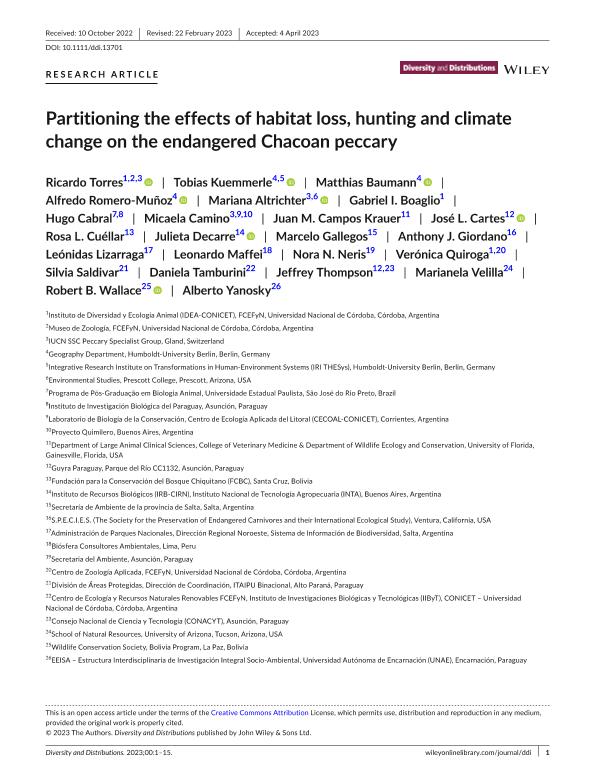Artículo
Partitioning the effects of habitat loss, hunting and climate change on the endangered Chacoan peccary
Torres, Ricardo Marcelo ; Kuemmerle, Tobias; Baumann, Matthias; Romero Muñoz, Alfredo; Altrichter, Mariana; Boaglio, Gabriel Ivan
; Kuemmerle, Tobias; Baumann, Matthias; Romero Muñoz, Alfredo; Altrichter, Mariana; Boaglio, Gabriel Ivan ; Cabral, Hugo; Camino, Micaela
; Cabral, Hugo; Camino, Micaela ; Campos Krauer, Juan M.; Cartes, José L.; Cuéllar, Rosa L.; Decarre, Julieta; Gallegos, Marcelo; Giordano, Anthony Joseph; Lizarraga, Leónidas; Maffei, Leonardo; Neris, Nora N.; Quiroga, Verónica Andrea
; Campos Krauer, Juan M.; Cartes, José L.; Cuéllar, Rosa L.; Decarre, Julieta; Gallegos, Marcelo; Giordano, Anthony Joseph; Lizarraga, Leónidas; Maffei, Leonardo; Neris, Nora N.; Quiroga, Verónica Andrea ; Saldivar, Silvia; Tamburini, Daniela Maria; Thompson, Jeffrey; Velilla, Marianela; Wallace, Robert B.; Yanosky, Alberto
; Saldivar, Silvia; Tamburini, Daniela Maria; Thompson, Jeffrey; Velilla, Marianela; Wallace, Robert B.; Yanosky, Alberto
 ; Kuemmerle, Tobias; Baumann, Matthias; Romero Muñoz, Alfredo; Altrichter, Mariana; Boaglio, Gabriel Ivan
; Kuemmerle, Tobias; Baumann, Matthias; Romero Muñoz, Alfredo; Altrichter, Mariana; Boaglio, Gabriel Ivan ; Cabral, Hugo; Camino, Micaela
; Cabral, Hugo; Camino, Micaela ; Campos Krauer, Juan M.; Cartes, José L.; Cuéllar, Rosa L.; Decarre, Julieta; Gallegos, Marcelo; Giordano, Anthony Joseph; Lizarraga, Leónidas; Maffei, Leonardo; Neris, Nora N.; Quiroga, Verónica Andrea
; Campos Krauer, Juan M.; Cartes, José L.; Cuéllar, Rosa L.; Decarre, Julieta; Gallegos, Marcelo; Giordano, Anthony Joseph; Lizarraga, Leónidas; Maffei, Leonardo; Neris, Nora N.; Quiroga, Verónica Andrea ; Saldivar, Silvia; Tamburini, Daniela Maria; Thompson, Jeffrey; Velilla, Marianela; Wallace, Robert B.; Yanosky, Alberto
; Saldivar, Silvia; Tamburini, Daniela Maria; Thompson, Jeffrey; Velilla, Marianela; Wallace, Robert B.; Yanosky, Alberto
Fecha de publicación:
05/2023
Editorial:
Wiley Blackwell Publishing, Inc
Revista:
Diversity and Distributions
ISSN:
1366-9516
e-ISSN:
1472-4642
Idioma:
Inglés
Tipo de recurso:
Artículo publicado
Clasificación temática:
Resumen
Aim: Land-use change and overexploitation are major threats to biodiversity, and climate change will exert additional pressure in the 21st century. Although there are strong interactions between these threats, our understanding of the synergistic and compensatory effects on threatened species´ range geography remains limited. Our aim was to disentangle the impact of habitat loss, hunting and climate change on species, using the example of the endangered Chacoan peccary (Catagonus wagneri).Location: Gran Chaco ecoregion in South America.Methods: Using a large occurrence database, we integrated a time-calibrated species distribution model with a hunting pressure model to reconstruct changes in the distribution of suitable peccary habitat between 1985 and 2015. We then used partitioning analysis to attribute the relative contribution of habitat change to land-use conversion, climate change and varying hunting pressure.Results: Our results reveal widespread habitat deterioration, with only 11% of the habitat found in 2015 considered suitable and safe. Hunting pressure was the strongest single threat, yet most habitat deterioration (58%) was due to the combined, rather than individual, effects of the three drivers we assessed. Climate change would have led to a compensatory effect, increasing suitable habitat area, yet this effect was negated by the strongly negative and interacting threats of land-use change and hunting.Main Conclusions: Our study reveals the central role of overexploitation, which is often neglected in biogeographic assessments, and suggests that addressing overexploitation has huge potential for increasing species´ adaptive capacity in the face of climate and land-use change. More generally, we highlight the importance of jointly assessing extinction drivers to understand how species might fare in the 21st century. Here, we provide a simple and transferable framework to determine the separate and joint effects of three main drivers of biodiversity loss.
Archivos asociados
Licencia
Identificadores
Colecciones
Articulos(CECOAL)
Articulos de CENTRO DE ECOLOGIA APLICADA DEL LITORAL (I)
Articulos de CENTRO DE ECOLOGIA APLICADA DEL LITORAL (I)
Articulos(IDEA)
Articulos de INSTITUTO DE DIVERSIDAD Y ECOLOGIA ANIMAL
Articulos de INSTITUTO DE DIVERSIDAD Y ECOLOGIA ANIMAL
Articulos(IIBYT)
Articulos de INSTITUTO DE INVESTIGACIONES BIOLOGICAS Y TECNOLOGICAS
Articulos de INSTITUTO DE INVESTIGACIONES BIOLOGICAS Y TECNOLOGICAS
Citación
Torres, Ricardo Marcelo; Kuemmerle, Tobias; Baumann, Matthias; Romero Muñoz, Alfredo; Altrichter, Mariana; et al.; Partitioning the effects of habitat loss, hunting and climate change on the endangered Chacoan peccary; Wiley Blackwell Publishing, Inc; Diversity and Distributions; 5-2023; 1-15
Compartir
Altmétricas



